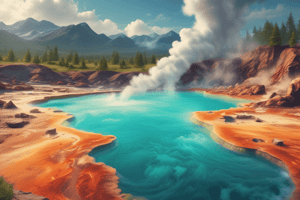Podcast
Questions and Answers
What is the primary factor that impacts the quality of spring water?
What is the primary factor that impacts the quality of spring water?
- Contaminants from sewers and factories
- Fertilizers and chemicals in farm lands
- Industrial developments nearby
- Proximity to residential areas (correct)
Why is caution advised when drinking naturally occurring spring water?
Why is caution advised when drinking naturally occurring spring water?
- Fluctuating water quality (correct)
- Absence of bacteria
- High-quality water
- Presence of beneficial minerals
What type of springs are characterized by areas with ongoing or volcanic activity history?
What type of springs are characterized by areas with ongoing or volcanic activity history?
- Thermal springs (correct)
- Mineral springs
- Underground springs
- Rain springs
What elements associated with igneous rocks are present in hot springs?
What elements associated with igneous rocks are present in hot springs?
How can spring water be beneficial for human health?
How can spring water be beneficial for human health?
What is the continuous feeding of surface water by the seeping of a shallow groundwater reservoir called?
What is the continuous feeding of surface water by the seeping of a shallow groundwater reservoir called?
How are aquifers formed?
How are aquifers formed?
What geological characteristic can lead to aquifer water seeping or leaking to the surface to form springs?
What geological characteristic can lead to aquifer water seeping or leaking to the surface to form springs?
In what form does the water inside aquifers move through rocks?
In what form does the water inside aquifers move through rocks?
Why do reservoirs with faults or fractures hold more water?
Why do reservoirs with faults or fractures hold more water?
What is the main difference between unconfined and confined aquifers?
What is the main difference between unconfined and confined aquifers?
What geological feature is essential for the formation of artesian springs?
What geological feature is essential for the formation of artesian springs?
In which type of geological unit are seepage springs commonly observed?
In which type of geological unit are seepage springs commonly observed?
What geological feature primarily determines the movability of water in tubular springs?
What geological feature primarily determines the movability of water in tubular springs?
Which factor significantly influences the discharge classification of springs?
Which factor significantly influences the discharge classification of springs?
Flashcards are hidden until you start studying





